In a prior blog I described bidding on a Ruger .357 Blackhawk that had been owned by Hank Williams, Jr. The Rock Island Auction folks predicted the gun would sell for between $900 and $1,600, and I wanted it so I put in a bid at $2,000 (which I thought was ridiculously high). That gun sold for $5,000. There are evidently guys out there who have the disease worse than me.
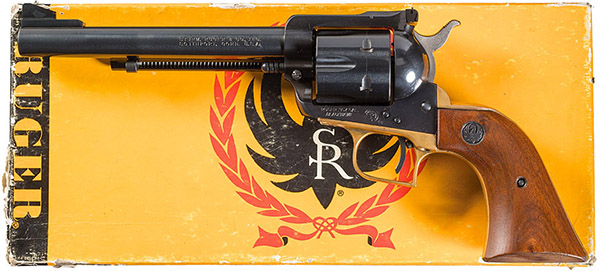
Then last month another Rock Island auction rolled around, and this one had a Ruger .357 Bisley. The concept and history of the Bisley is interesting. Bisley is the name of a target range in England, and when Colt introduced a target variant of its famed Single Action Army revolver in 1894, they named it the Colt Bisley. The most obvious differences between the Bisley and a standard Single Action Army is the Bisley’s longer grip with a more pronounced hump. Colt’s Bisley also had a rear sight that is adjustable for windage and interchangeable front sight posts for elevation adjustment.
Ruger introduced a modern Bisley version of its Blackhawk revolver line in 1985 (with revolvers chambered in .357 Magnum, .41 Magnum, .44 Magnum, and .45 Colt). I always thought the Ruger Bisley was a marketing thing and I thought the Bisley’s odd-shaped handle was visually unappealing, so I never felt the need for one. But needs and wants can change. A friend of mine let me try his .357 Magnum Ruger Bisley a few years ago. I liked its heft and slightly longer barrel (7 1/2 inches versus the standard Blackhawk’s 6 1/2 inches). Ruger stopped making the .357 Magnum Bisley a few years after it was introduced, and they are hard to find now.
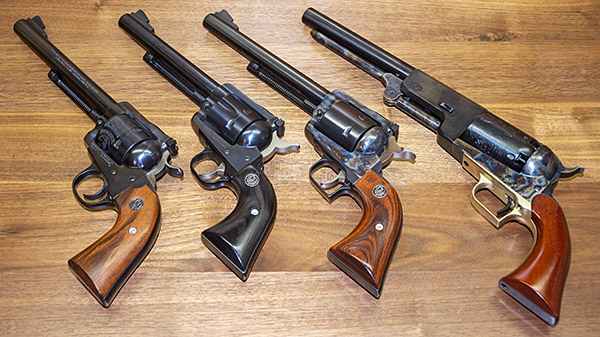
The modern Ruger Bisley has a massive appearance, and that’s kind of cool. At 7 1/2 inches, the barrel is an inch longer than the .357 Blackhawk and the Bisley has the larger grip frame. The Bisley grip frame feels awkward to me, but it is easier on the hand under heavy recoil. I’m probably just used to the standard Blackhawk grip frame. For me, the larger Super Blackhawk grip frame is the best of all.
Some might call these big guns horse pistols, which have been defined as handguns usually carried in a holster while riding a horse. The Bisley is smaller than a Colt Walker (a monster of a handgun), but by any other measure the Bisley is a huge revolver. It is heavier than the regular .357 Magnum Blackhawk for four reasons: The unfluted cylinder, the longer barrel, the grip is larger, and the gripframe is made of steel instead of aluminum.
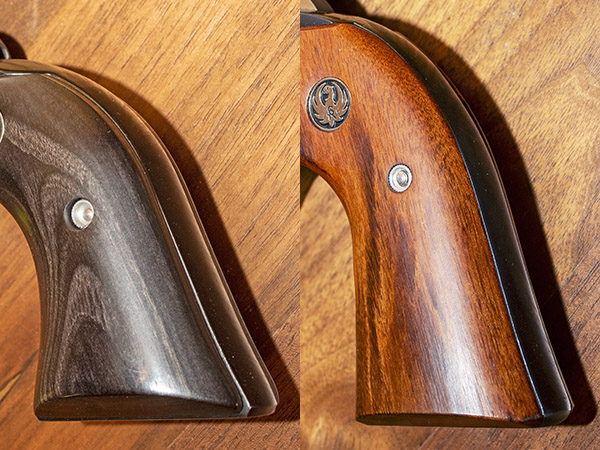
The Rock Island folks guessed that the Ruger Bisley would go for between $600 and $900 on their website before the auction. I bid $600. I wanted it, but not so badly that I was willing to go crazy, which is kind of what my previous results told me you had to be to win in the Rock Island crazy competition. To my great surprise, I won the Bisley with my $600 bid. Then I received the emailed invoice and I was even more surprised. There was a 17.5% buyer premium, which tacked another $105 to the price. There was a 3.5% credit card fee, so that was $21. The gun had to ship 2nd day air to my FFL, and that was $46. There was insurance, and that added $7.05. And of course, the Peoples Republik of Kalifornia sales tax for another $60.39. My $600 Bisley suddenly became an $839.44 toy and it hadn’t even arrived. When it did, there was the California DOJ fee and the FFL transfer fee ($74.90). My $600 Bisley was now up to $914.34. I guess that’s okay, though. If I had seen a .357 Ruger Bisley in new condition for a thousand bucks, I would have pulled the trigger (literally and figuratively) and felt good about it. In that sense, I was $85.66 ahead of the game.
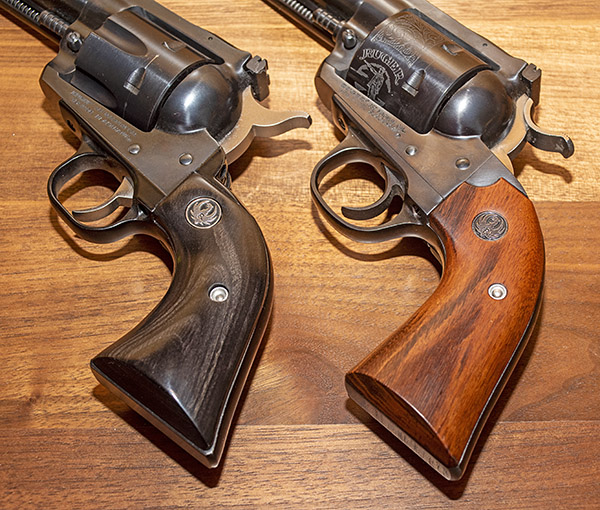
When I saw the gun in person (the day I started my 1o-day waiting period), I was blown away (figuratively speaking, of course). I could see that it was in excellent condition. The quality, fit, and finish are light years ahead of what Ruger is producing these days. You’ll recall that when I lost the Hank Williams Auction I bought a new Ruger .357 Blackhawk and its quality was terrible. The Ruger Bisley’s quality appears to be much better in both fit and finish. I looked up the Bisley’s serial number on Ruger’s website and learned that my gun was manufactured in 1986; I guess Ruger cared more about what was leaving the factory back then.
I’ve been to the range a couple of times with my Bisley. On my first day out with the new-to-me Ruger, one of my friends (a bench rest shooter) came over to watch. There was an old bowling pin laying on its side on the 100-yard line. You know the situation…like the bad guy in an old western movie, it was just begging to be shot. I asked my friend to spot for me. The first shot went high, kicking up a dust cloud about three feet above the pin. I held lower and my second shot sent up another dust cloud two feet below the pin. Okay, I had the elevation dialed in (I wasn’t actually adjusting the Bisley’s sights; I was just holding the front post at different heights). My third shot hit just to the right. On my fourth shot I nailed it, sharply kicking the bowling pin back 10 yards and spinning it violently. Now, just the pin base was facing me, presenting a 3-inch diameter circle. “Okay, let’s see you make that shot,” my friend said. I did, and the pin was kicked back another 10 yards. I looked back and smiled. “Piece of cake,” I said, and we both had a good laugh.
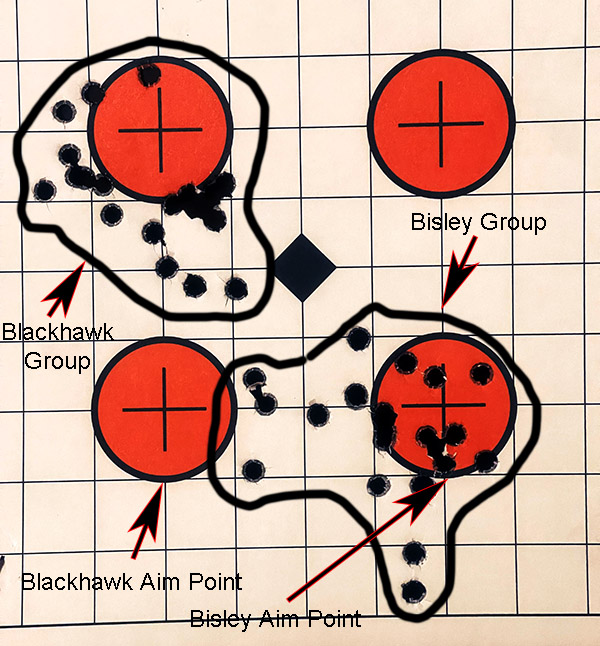
On a subsequent range outing I compared the Bisley’s accuracy to the regular Blackhawk using the same heavy .357 Magnum load in both revolvers (8.0 grains of Unique and the Hornady 158-grain XTP jacketed hollow point bullet). They both shoot groups that were about the same size, and both are biased with the sights adjusted as far as they will go. The regular Blackhawk shoots high at 25 yards with the rear sight all the way down (the front sight is not tall enough). The Blackhawk prints about 3 inches high at 25 yards with the rear sight adjusted as low as it will go. I’ve contacted Ruger and they sent me their shortest rear sight blade for the Blackhawk, but that’s the one the revolver already had in it. Custom gunsmiths offer a taller front sight (Fermin Garza comes to mind), but I don’t know if I want to do that. It’s custom work I shouldn’t have to pay for.
The Bisley’s elevation is okay at 25 yards, but it shoots to about one inch to the left at 25 yards. When I received the revolver from Rock Island Auctions, the rear sight had been cranked almost all the way to the right by the former owner. He ran out of adjustment range and the gun still shoots to the left of my aim point. I thought that the leftward bias could be due to a poor ejector rod shroud fit, or it may just be due to the fact that I was shooting max loads and it’s how the gun reacts in my hand. I fired a few rounds of .38 Special wadcutters and the gun still shot to the left, so I don’t think it is a function of how hot a load I’m shooting or how it reacts to my grip. Then I took the ejector rod shroud off to see if that would make a difference. The ejector rod shroud was very poorly fit to the Bisley and it was pulling the barrel to the right, but when I took it off, the point of impact did not change. You would think the manufacturer would deliver a gun that shot to a point that was within the gun’s adjustable sight range. I’ve been inside a revolver manufacturing facility (not Ruger), and all they do is proof each gun with a high pressure load; that other manufacturer did not check where the gun printed. Ruger evidently does not, either.
The regular Ruger Blackhawk ejects all cases easily (even with the max loads I was using). The Bisley does not. With the max loads I shot in the Bisley, one chamber wants to hang on to the cartridge case. Less than max loads (38 Special and mid-range .357 mag loads) eject satisfactorily from the Bisley. The Bisley has a sloppy surface finish inside its chambers (there are machine marks from the chamber reaming operation). It shouldn’t have left the factory back in 1986 like that, but it did.
There’s one other quality-related observation on the Bisley I should mention. The Bisley makes a firing pin primer indentation in the primer that is bigger and deeper than any I have ever seen. Looking at the firing pin after it has been hit by the hammer, it looks bigger and sticks out of the breech face more than I am used to seeing. I had a bunch of max load .357 rounds with Aventuras primers I had assembled earlier, and Bisley pierced the primers on the first five (so I didn’t shoot any more of those). The firing pin is smooth and round (there are no sharp edges on it); it’s just taking the primer cup material near enough to its yield point that the pressure takes it the rest of the way. These same cartridges worked fine in my regular (i.e., non-Bisley) Blackhawk with no pierced primers, and the same .357 load with CCI primers and Winchester primers worked fine in the Bisley. Note to self: Don’t use Aventuras primers for hot .357 loads in the Bisley.
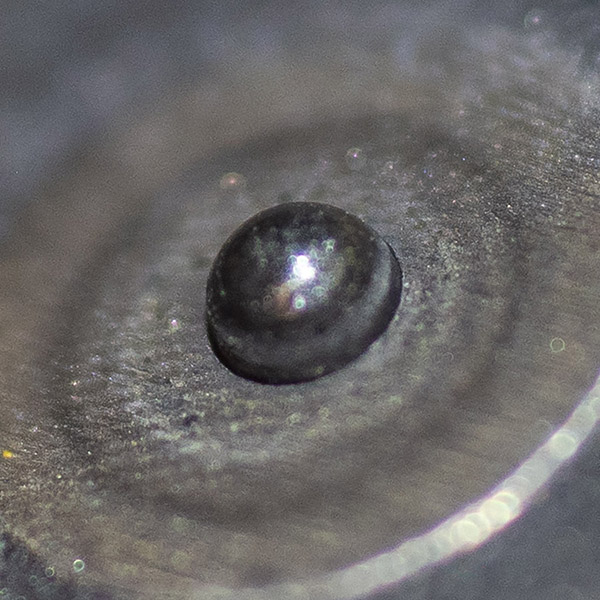
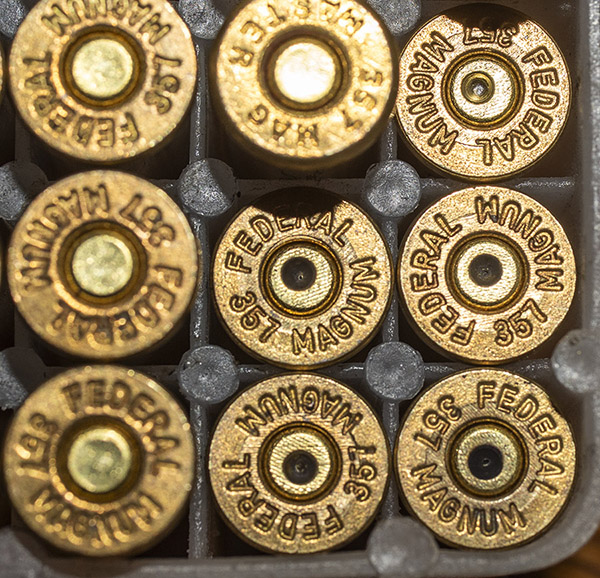
So there you have it. My knowledge base on the Ruger .357 revolvers continues to grow (and yours does, too, if you’re reading this). I’m still looking for that perfect .357 Magnum revolver. I’ve owned a bunch over the last 50+ years, and I’ll keep looking. I still dream about wandering into a rural pawnshop somewhere and finding a brass grip Blackhawk like that Hank Williams, Jr., Ruger for $200. You never know.
More Tales of the Gun!
Never miss an ExNotes blog:

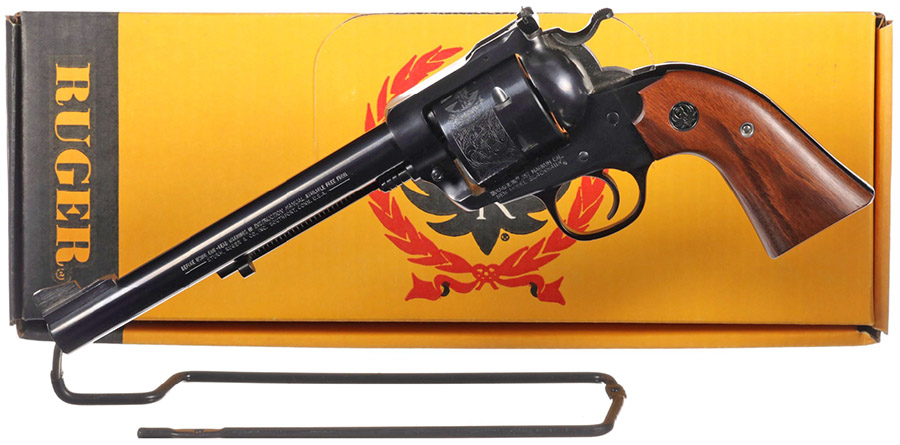


Did I miss something? I thought you weren’t buying any more guns.
Nope, as always, you didn’t miss a thing. This was one I bought a few weeks ago (before the New Year). Although I did wake up this morning thinking about another 9mm. At my age, the concern is reducing the collection to something less apocalyptic. I don’t want my heirs to have to deal with it after I’m gone. Hopefully, that’s not going to be any time soon.
Great review. Are the Bisley trigger and hammer shapes different than the Blackhawk?
Thought I read somewhere that they were.
Thanks!
Thanks for commenting, Kelly. They are different than the regular Blackhawk.